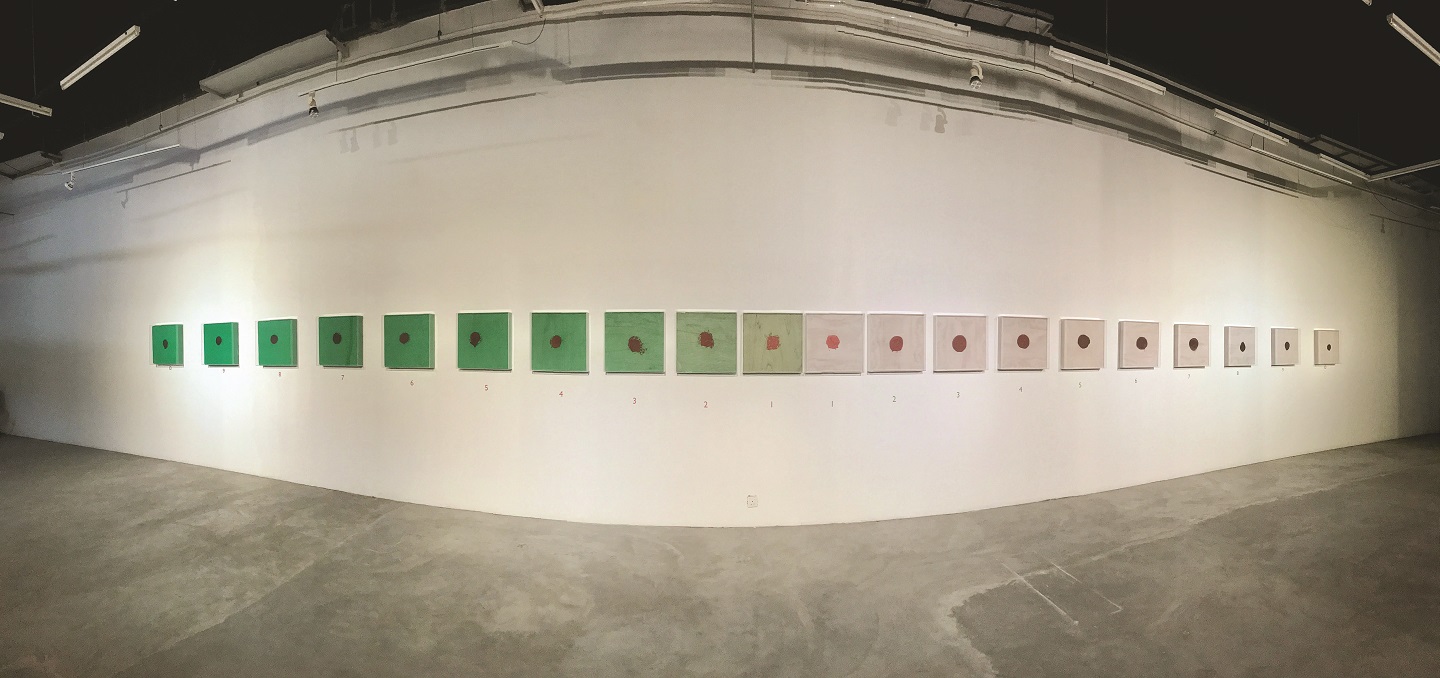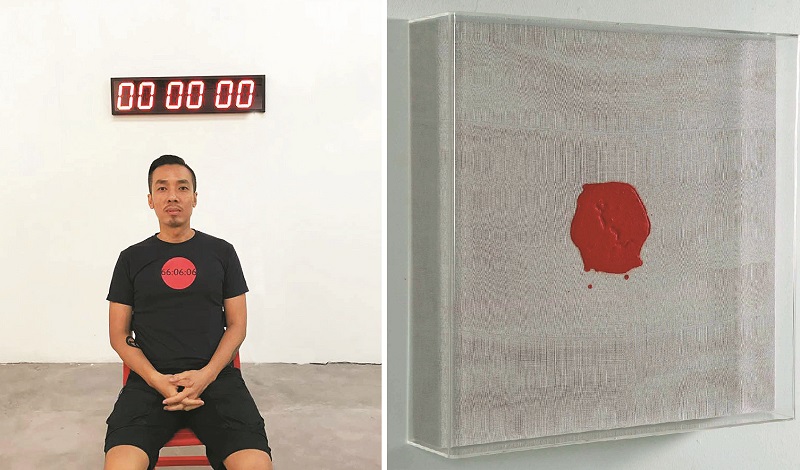
(Photo: Wei-Ling Contemporary)
There must be some sort of irony in an art performance that involves watching paint dry, but in the case of Ivan Lam’s latest minimalist work, watching him pour red paint onto layers of nets and seeing it slowly drip onto a white canvas below is a contemplative experience.
On a recent evening at Wei-Ling Contemporary, Lam launched his latest project, Hymen — yes, you read that right and, yes, the “artworks” are really just a series of red paint splotches on green construction safety netting and white canvases fashioned from cloth diapers.
“There were people who asked me if I spelt the title correctly and if I meant something else,” says Lam with a wry smile.
The established contemporary artist, who has dabbled in various mediums, is well known for his skill in painting, even if he is somewhat obsessive about not doing the same thing twice. “If I start repeating myself, if I’m not having fun anymore, I should quit,” he emphasises at one point.
Nevertheless, this series is daring even for Lam, the arrival to which he confesses required him to get out of his comfort zone, in a personal and professional capacity.
Addressing the obvious connotations of the series, the 43-year-old divulges the personal motivation that led him to jump in on what is a timely discussion on the autonomy of the female body and the corresponding societal, cultural and political discourse.
“My eldest daughter is changing physically now … and I have no clue how to deal with that. It’s a subject that as a parent — how do I broach it? Do I just pass the buck to the mum? All my life, I’ve been surrounded by women, my mum, my two sisters, grandmother, great-grandmother, my wife, daughters, my gallerist, even my dog. It seems like fate. And instead of passing the buck, I decided ‘why don’t we take this head on?’ I want to learn, to know more and explore these issues that everyone can relate to, but yet are always treated with hush-hush taboo, a mystifying thing. As an artist, I can really push it further, get away with more,” Lam reflects.
As a male voice, Lam’s journey, and resulting artistic outcome may not be particularly intimate. But that is not his intention. One gets the sense that he is not here to bring answers to the complexity of the topic, but like the undeniable evidence of womanhood, the “blood” stains are an unflinching visual statement.
“It started as something personal, but when you find that it’s such a universal topic —I mean we have the ‘#MeToo’ campaign, Time’s Up movement ... I think it’s so relevant to the now. And this work is about bringing people to the discourse. The value comes from its translation, like how we are talking now — we are translating the image into thought and then into words,” Lam says.

And he’s more than happy to step back and let it have a life of its own. Perhaps the most interesting thing about Hymen is that the work itself reveals no trace of Ivan Lam the artist. In fact, through the performance and a video showing the creative process, Lam reveals it all and yet subversively makes it about what is not seen.
What is the value of an artist or his artwork when he “de-skills” himself? After more than 20 years as an artist, he says he has come to understand that value can be inherent but abstract.
“When you have this kind of work, you surrender part of your ego, you can’t force it. I spent six months to get this out. It’s a slow process. It’s also taught me that you have to surrender and listen, rather than force your way. And it can be of temporal value. After all, that mirrors life itself,” he says thoughtfully.
That introspection is imbued in the project, which is subtle yet detailed in its symbolism: be it of his approach to fatherhood or his artistic ethos. The 20 framed square canvases — 10 each in green and white — look identical from afar, but a closer look reveals minute variations in terms of thinness of the “blood” and its colourisation.
In the green netting works, each number indicates the layers of nets used — up to 10 layers — the stains on top of which represents indellible marks of what is inevitable. Also unavoidable is the consequence of that process, which dictates the resultant shape of the stains on the white canvases. He draws a parallel to his relationship with his daughters, “The green and the white cannot exist without one another. And yet, the green cannot stop the white from being stained.
“As a parent, there’s always the urge to protect your child. But I couldn’t, I can’t.” The implications of that statement strike a chord when one thinks of how, in the same way, female sexuality and a woman’s body have been the subject of control and in some cases, suppression, on various levels.
In his creative process, Lam also varied the height difference from which the paint would drip onto each canvas, creating an unnoticeable undulation of rhythm that is nonetheless very much present, conceptually alluding to the cycle of life that a woman carries, literally, within and through her.
“Actually, if I continued to up the layers of netting, the paint would not get through. But I realised the futility of heading there. It’s not about protection, but more about letting go. Just like I let go of my identity in this process, I have to learn to let them [my daughters] grow up on their own. I can only provide security and stability, but the real world will be their teacher,” he concludes.
Wei-Ling Contemporary, 6th floor, The Gardens Mall, KL. 03 2282 8323. Until Apr 29. This article first appeared on Apr 9, 2018 in The Edge Malaysia.


